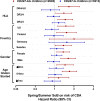Risk of celiac disease autoimmunity is modified by interactions between CD247 and environmental exposures
- PMID: 39462122
- PMCID: PMC11567144
- DOI: 10.1038/s41598-024-75496-w
Risk of celiac disease autoimmunity is modified by interactions between CD247 and environmental exposures
Abstract
Season of birth, viral infections, HLA haplogenotypes and non-HLA variants are implicated in the development of celiac disease and celiac disease autoimmunity, suggesting a combined role of genes and environmental exposures. The aim of the study was to further decipher the biological pathways conveying the season of birth effect in celiac disease autoimmunity to gain novel insights into the early pathogenesis of celiac disease. Interactions between season of birth, genetics, and early-life environmental factors on the risk of celiac autoimmunity were investigated in the multicenter TEDDY birth cohort study. Altogether 6523 genetically predisposed children were enrolled to long-term follow-up with prospective sampling and data collection at six research centers in the USA, Germany, Sweden and Finland. Celiac disease autoimmunity was defined as positive tissue transglutaminase antibodies in two consecutive serum samples. There was a significant season of birth effect on the risk of celiac autoimmunity. The effect was dependent on polymorphisms in CD247 gene encoding for CD3ζ chain of TCR-CD3 complex. In particular, children with major alleles for SNP rs864537A > G, in CD247 (AA genotype) had an excess risk of celiac autoimmunity when born March-August as compared to other months. The interaction of CD247 with season of birth on autoimmunity risk was accompanied by interactions with febrile infections between the ages of 3-6 months. Considering the important role of TCR-CD3 complex in the adaptive immune response and our findings here, CD247 variants and their possible effect of subgroups in autoimmunity development could be of interest in the design of future gene-environment studies of celiac disease. ClinicalTrials.gov Identifier: NCT00279318.
© 2024. The Author(s).
Conflict of interest statement
The authors declare no competing interests.
Figures




References
Publication types
MeSH terms
Substances
Associated data
LinkOut - more resources
Full Text Sources
Medical
Research Materials

